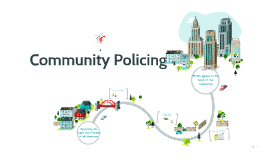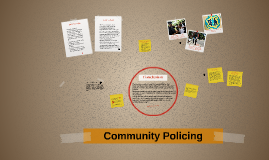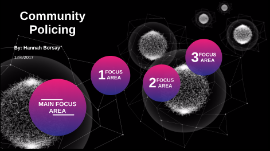Community Policing.
Transcript: Physical Characteristics - Suburban area - Child friendly area - Community opportunities - Main road routes Yes. Working with the Community Access Control http://www.peelpolicemaps.ca/ Access Control artnerships: Citizens of the community, Morgaurd Property Management Team, Peel Regional Police, City of Brampton, Business owners in the community. - Alert surrounding businesses of proposed plan. -Arrange public information meetings to better understand the publics needs and wants. -Work in tandem, with community out-reach programs. -Allow members of the community to have an electoral vote on the project by presenting multiple scenarios and options. -Involve necessary Government bodies. Goals to keep in mind: a) Restore community based policing efforts b) Restore community appearance and upkeep, c) Plan for long term and adapt to change as years and ideas progress d) Staying focused on the Original Complaint addressing the matter as required. Largely identifiable entrance ways. Indicates people to use this entrance making it much more easier to locate people. Bramalea City Centre - Bus Terminal Users of the transit terminal as well as those who we Yes, broken window theory A feel need to be involved. lient: City of Brampton, Bramalea Community Access control gone wrong! A esponse: Cleansing of area, higher police patrol, advanced security technology and foot patrol, community awareness. C Stake Holders: letters, out-reach programs, electoral vote, incentive programs. The ability to easily view the inside and outside of the facility through a glass structure make criminal behaviour less likely as there is a much higher chance to be caught. Crime Over the Past 30 Days! R Territorial Reinforcement Small chance of conflict from persons creating the problem. Involvement Problem Solving Method: CAPRA cquire: Problem identified as, loitering, littering, smoking, drugs, disorderly behavior Political Issue: Systemic Issue: Connection Strategies: Conflict: Restorative Justice: Surroundings: Peel Regional Police Bramalea City Centre Knightsbridge community Civic Centre And many more.. Problem Statement approach in their wards. ssessment: Rate of current problem decrease, Broken Window Theory eliminated, less timid area. Community Policing & Development Project This photo shows an attempt to limit access to the meter by fencing the area as well as locking the gate. Although this idea does prevent vandalism it gives a chance of roof access to the building. During our CPTED Audit it was apparent that the newly built transit terminal was built following the guides of CPTED. As shown: In addition to this we were able to identify one area which could be addressed. As shown: Posting signs give a very clear indication that any of these acts if committed will be punishable by a court of law. - Mayor Susan Fennel - City Councilor Bob Callahan (Ward 3,4) - Director of Works and Transit T.W. Mulligan -Director of Economic Development and Communications Dennis Cutajar -Regional Councilor Sandra Hames and Gael Miles (Ward 7,8) -Regional Councilor John Sanderson (Ward 3,4) -Police Superintendent Steve Wollaston -Morgaurd Property Management Team -Residence of the area -Business owners of the area -Average age: 35 -Majority of area is businesses. -Small residential community (child friendly). -Race: Caucasian, African-American and South Asian. -MP: Bal Gosal of the Conservative party of Canada -Urban elements -Major shopping area -Surveys in order to identify our client and acquire about the problem -Previous crime data to help acquire about the problem -Help from community groups and Government initiatives as partnerships - Community policing as a response to the problem -C.P.T.E.D as a response to the problem as per the community design -Monthly and annual audits of the area in order to assess our work Yes. as regional councilors should take a proactive CPTED Audit Natural Surveillance P The above web link shows Peel Regional Police statistics for the following crimes in Peel Region: Homicide Robbery Muggings Break and enter Auto theft Theft from vehicle Mischief The complaint at hand is that there seems to be a high amount of drugs, loitering, disorderly behavior, noise, smoking and littering that is impacting the area. Our team came to discover a fair amount of the problems arising are being committed by a younger crowd mainly between the ages or 15-28 years of age. We were able to discover this as this is the majority age of the citizens that not only use the transit terminal but also attend the surrounding areas. Many students and young people use public transportation system to visit the mall and due to that fact the transit terminal becomes a hotspot for incidents involving youth. The above problem has become a very large nuisance to other who use the transit terminal and also those in the surrounding areas such as businesses, residents of the area, and Bramalea City Centre. We will certainly know our goals have been achieved

















